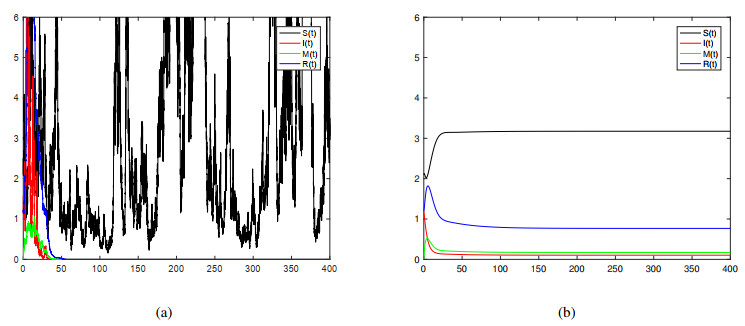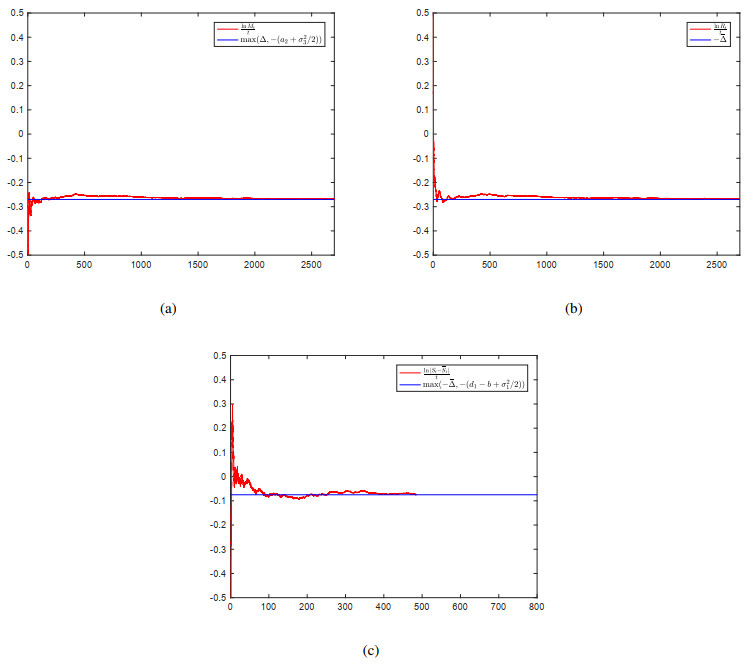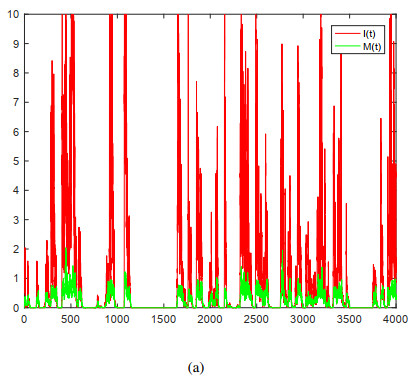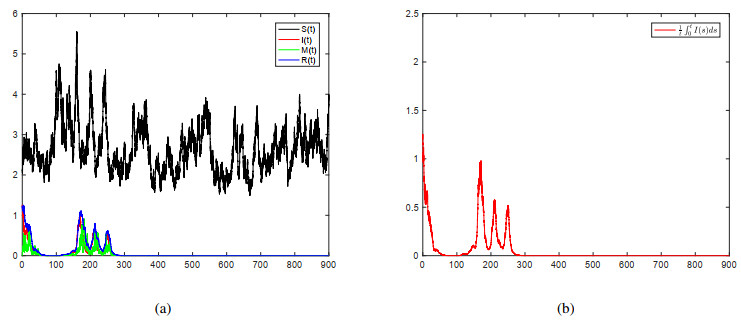1.
Introduction
Outbreaks of infectious diseases do great harm to life and fortune. The construction and research of mathematical models play an extremely important role in the prevention and control of diseases. Scholars have studied various properties of many epidemic models, such as SIR (Susceptible-Infected-Recovered), SEIR (Susceptible-Exposed-Infected-Recovered), SIRS, SIQS (Susceptible-Infected-Quarantined-Recovered), which portray different characteristics of disease transmission[1,2,3,4,5,6]. The authors in [6] studied the Hopf bifurcation and stability of a delayed SIR model. They established an epidemic model with temporary immunity and specific functional response[7], and got the well-possedness and the threshold to determine different behaviors of the model.
When an epidemic occurs, people can learn about the transmission route of the disease, prevention measures and the government's policy on disease control from media such as the TV or Internet, so that they can take certain measures to slow down the spread of the disease, such as self-isolation, vaccination, and compliance with the government's anti-epidemic regulations. On account of the role of media information on disease control, scholars have studied the different properties of epidemic models with information intervention[8,9,10,11,12]. At present, there are mainly two ways to study the impact of information intervention on the behavior. One is to study the impact of information intervention on the contact rate[8,9,13,14], and the other is to introduce a new class with information awareness[10,11,15,16]. In [15], the following epidemic model with separate information intervention class was established:
where St, It, Rt denote the quantity of the susceptible class, the infected class, and the recovered class at time t, separately. Mt represents the individuals of the class with information awareness. The meanings of the parameters in model (1.1) are shown in Table 1. In addition, a2 represents the degradation rate of information, which contains the subtraction due to the natural death of M. Thus, the assumption that a2>d1 is reasonable. The whole part d2m indicates response rate; the detailed meaning of each parameter on the information and schematic diagram of the above model can be seen in [15]. All the above parameters are specified as positive.
Reality is not immutable and often full of various uncertainties. The above deterministic model (1.1) can not reflect these uncertain factors. Therefore, the introduction of the model with stochastic noise will better reflect the reality and present more research contexts. For this reason, many scholars have studied epidemic models with various stochastic factors[17,18,19,20]. The authors have studied the nontrivial positive periodic solution and condition for extinction of the model with media coverage and white noise[18]. Bao-Shao investigated an SIRS model with Markovian switching, which is used to describe the changes of coefficients in different environments, and discussed the influence of Markovian switching on the behavior of the model. In this paper, we introduce the stochastic perturbation of white noise into the above model, whose intensity is proportional to each class, that is
Here, Wi(t),i=1,2,3,4 are mutually independent Brownian motions on probability space and σi,i=1,2,3,4 represent the intensities of the stochastic perturbations. The greater the stochastic perturbations, the deeper the impact on the system, the greater σi will be.
In addition to physical or respiratory transmission, there is also a form of vertical transmission from an infected mother to the newborns, such as with hepatitis B and AIDS. Vertical transmission from the mother to the newborn is considered as one of the most important ways of AIDS transmission. Thus, the epidemic models possessing vertical transmission have been extensively investigated[21,22,23]. The authors in [21] proposed an epidemic model with vertical transmission where the parameter b signifies the birth rate of the population and q stands for the proportion of newborns infected after birth from infectious mothers. p=1−q and d1>b≥0 is assumed. Therefore, pb expresses the rate of newborns who have not been infected by their mothers and become susceptible.
Hence, introducing the above factors, including the information intervention and vertical transmission, we can obtain the following stochastic model:
The above factors not only make the model more general, but also raise the degree of difficulty of the study. The novelties of this paper are as follows: (ⅰ) An epidemic model with information intervention and vertical transmission is established; (ⅱ) a threshold is obtained to determine the different dynamics of the model and the exponential rates of three classes are studied; (ⅲ) the critical case of Δ=0, which has rarely been discussed in the literature, is investigated here.
This paper is arranged as follows: In Section 2, some estimations of the solution are given, followed by some lemmas to be used later. Section 3 gives a rough illustration of the value for disease extinction and provides the main conclusions of the paper. Part 4 focuses on the proof of Theorem 3.1 and Proposition 3.1 in detail. Part 5 proves the persistence of the model when Δ>0 and obtains the condition that the model has a stationary distribution. Section 6 studies the critical case when Δ=0. Section 7 discusses the results of the paper and lists some examples and numerical simulations to check the previous results.
2.
Background knowledge
In this paper, (Ω,F,{F}t,P) is assumed to be a complete probability space and R4+:={(a,b,c,d)|a≥0,b≥0,c≥0,d≥0} and R4,o+:={(a,b,c,d)|a>0,b>0,c>0,d>0}. a∧b=min{a,b}. Ps,i,m0,r and Es,i,m0,r denote the probability and expectation with initial condition (s,i,m0,r), respectively.
For the general SDE dxt=f(xt)dt+g(xt)dW(t) and the twice-differentiable function V(x), the operator LV is defined by
In addition, the Itˆo′s formula can be expressed as
First of all, we are concerned with the existence and uniqueness as well as approximate scope of the solution. The following lemmas will respond to these problems.
Lemma 2.1.
(i) For the initial condition (s,i,m0,r)∈R4+, the model (1.3) has a global solution (St,It,Mt,Rt) that possesses Markov-Feller property. Moreover, the solution (St,It,Mt,Rt) will remain in R4+ with probability 1.
(ii) Let σ=max{σ1,σ2,σ3,σ4}, for 0<ϑ<p<θ<2(d1−b)σ2, there exist constants N1>0 and N2>0 satisfying
Proof. The proof of part (ⅰ) is common and omitted. Our main proof is part (ⅱ). Let V1(S,I,M,R):=(S+I+M+R)1+θ+S−ϑ. Direct calculation to V1(S,I,M,R) yields to
Let 0<ϑ<p<θ<2(d1−b)σ2, so ϑ(1+p)p<1+ϑ and −(d1−b)+θσ22<0 hold true. By using Young's inequality, it has
and
Hence,
Let N1=d1−b−θσ22, then LV1(S,I,M,R)+N1V1(S,I,M,R)≤N2, where
The rest of the process is standard; one can see Lemma 2.3 in [24]. Thus, (2.3) is obtained. □
Lemma 2.2. For all initial conditions (s,i,m0,r)∈R4+, the solution (St,It,Mt,Rt) of (1.3) satisfies
hence,
Moreover, it has
Proof. For (2.4), the proof is analogous to Lemma 3.1 in [22], mainly utilizing the result of Theorem 3.9 in [25], so it is omitted here. The proofs for (2.5) can be derived from (2.4) and strong law of large numbers.
For limt→∞lnStt≤0 and other formulas in (2.6), we recommend Lemma 2.3 in [26] to get a detailed proof. In addition, the property that ES−ϑt<∞ will lead to lim inft→∞lnStt≥0, so limt→∞lnStt=0 is obtained.
□
3.
The threshold to determine the extinction or permanence of model (1.3)
We will give a value in this section and roughly explain it as the threshold of the extinction or persistence of model (1.3).
Take into account the first equation of model (1.3) on the boundary It=0, Mt=0, and Rt=0, it has
Let ˉSut be the solution to (3.1) with the initial condition ˉS0=u. It should be noted that St≤ˉSt,t>0 cannot be obtained by using the comparison theorem. Applying the Itˆo′s formula to the function ˉS−1−lnˉS and making use of the result in [27], there exists the unique stationary distribution π0 for (3.1) with the density
where ˉv=2(d1−b)σ21+1, ˉu=2Λσ21, Γ(⋅) is the Gamma function. We get from the strong law of large numbers that
Calculating the second formula of model (1.3), it has
Intuitively, if lim supt→∞lnItt<0, then limt→∞It=0. This leads to the results limt→∞Mt=0, limt→∞Rt=0, which will be explained in detail later. Thus, we have St≈ˉSt if t is sufficiently large, then one can anticipate that
Defining the value
Hence, lim supt→∞lnItt will tend to Δ above. If Δ<0, then lim supt→∞lnItt will be negative, and the disease will die out. Conversely, when Δ>0, no matter how small the initial value I0 is, It tends to be large for a sufficiently long time. The above description seems simple; however, the proof requires careful and rigorous implementation.
Now, we present the main conclusions of this paper, the proof of which will be given in the later section. Let RS0=βΛ(d1−b)(d1+γ+μ−qb+12σ22).
Theorem 3.1. When Δ<0, or equivalently RS0<1, the solution (St,It,Mt,Rt) with the initial condition (s,i,m0,r)∈R4,o+ satisfies
(3.6) implies that the disease It becomes extinct at an exponential rate.
Theorem 3.1 gives a condition to judge the extinction of the disease.
Proposition 3.1. If Δ<0, let ¯Δ:=min{−Δ,a2+12σ23,d1+δ+12σ24}>0 and ¯Δ1:=min{−Δ,a2+12σ23}>0, then
Furthermore,
Definition 3.1. [28] The disease in model (1.3) is called to be persistent in the mean, if the following inequality holds
Theorem 3.2. For the solution (St,It,Mt,Rt) with the initial condition (s,i,m0,r)∈R4,o+, when Δ > 0, that is, RS0>1, the disease It in model (1.3) is persistent in the mean. Moveover, the solution (St,It,Mt,Rt) has the invariant probability measure.
Remark 3.1. According to Theorems 3.1 and 3.2, we know that the sign of Δ will judge extinction or persistence of model (1.3) and RS0 can be regarded as the reproduction number, which depicts the number of second-generation infections after a single infected one enters the population.
4.
The case of Δ<0
In this section, we will prove Theorem 3.1 and Proposition 3.1 with the assumption that Δ<0.
4.1. Proof of Theorem 3.1
First, consider the equation
Similar to the Eq (3.1), a suitable Lyapunov function can be proved to obtain the invariant measure πε with density
Lemma 4.1. Provided that Δ<0, for any ϵ>0 and H>0, there is a constant δ1>0 such that for any (s,i,m0,r)∈[0,H]×[0,δ1]3 (where [0,δ1]3 represents [0,δ1]×[0,δ1]×[0,δ1]), it has
Proof. Let (s,i,m0,r)∈[0,H]×[0,δ1]3. For the 0<ε1<(d1−b)ˉΔ8β (ˉΔ is defined in Proposition 3.1), consider the Eq (4.1) with ε replaced by ε1, the ergodicity of solution with the initial data s denoted by ˉSε1,st leads to
If the initial value is not emphasized later, we still use ˉSε1t to express the solution of the equation.
Thus, there is a constant T1 such that P(ΩH1)>1−ϵ5, where
Due to ˉSε1,st≤ˉSε1,Ht for s≤H, it yields Ps(Ω1)>1−ϵ5 for s∈[0,H].
Because limt→∞σiWi(t)t=0,a.s., i=1,2,3,4, it has for some constant T2, P(Ω2)>1−ϵ5, where
Assume that T=max{T1,T2}; thanks to Lemmas 2.1 and 2.2, then for some positive constants C1 and K, it has P(Ω3)>1−ϵ5 and P(Ω4)>1−ϵ5, where
and
Let K above be sufficiently large such that P(Ω5)>1−ϵ5. Here,
Choose δ1 sufficiently small so that
and
Here, C2 and C3 will be determined in (4.11) and (4.12), respectively, later.
Let the stopping time be defined as
From the second equation, we get
Similarly, the third and fourth equations of (1.3) result in
and
where Ψ1(t)=exp{−(a2+σ232)t+σ3W3(t)} and Ψ2(t)=exp{−(d1+δ+σ242)t+σ4W4(t)}.
Hence, we get from (4.6) that for almost every ω∈Ω4∩Ω5 and t∈[0,T∧τ], it has
Moreover, the expression of Ψ1(t) leads to that for ω∈Ω5,
Thus, when ω∈∩5i=4,
Due to (4.4), it has
In the same way, for t∈[0,T∧τ] on ∩5i=4,
and
Thus, it yields from (4.8) and (4.4) that
Hence, for (s,i,m0,r)∈[0,H]×[0,δ1]3 on almost every ω∈∩5i=4, we have
Next, we shall prove the assertion τ=∞ for almost every ω∈∩5k=1Ωk.
First, when t∈[T,τ], it has Sv≤ˉSε1v for all v∈[0,t] by comparison principle; then for almost ω∈∩5k=1Ωk,
One can rewrite Mt on t≥T that
For almost every ω∈Ω2, exp{−(a2+σ232)t−18ˉΔt}≤Ψ1(t)≤exp{−(a2+σ232)t+18ˉΔt} is obtained and
Therefore, there exists a positive constant C2 satisfying
where
Similarly, rewriting the expression of Rt (4.8) yields
For almost all ω∈Ω2, we have
For almost all ω∈∩3i=1Ωi and t>T, it has
Similar to the proof of Mt, it has
Thus,
where
Assume that n is an integer with n>T. We get from the estimation of It, Mt and Rt for t∈[0,n∧τ] and almost every ω∈∩5k=1Ωk that
and
These results imply n≤τ on almost every ω∈∩5k=1Ωk. On the basis of arbitrariness of n, the assertion τ=∞ is obtained. In addition, from the estimation of It, Mt, and Rt, one has
This will lead to the (4.2) for any initial condition (s,i,m0,r)∈[0,H]×[0,δ1]3 on almost ∩5k=1Ωk with P(∩5k=1Ωk)≥1−ϵ. □
The subsequent proof of Theorem 1 is analogue to that of Theorem 2.2 in [29], so it is omitted here.
4.2. Proof of Proposition 3.1
Now, we provide the proof of the Proposition 3.1. From (3.6), we get that for any small ϵ1, there exist positive random variables ξ1, ξ2 satisfying that for t>0,
Due to the expression of Ψ1(t), it yields
This means there exist random variables ξ3>0, ξ4>0 satisfying that for t>0,
By virtue of (4.7) and the increasing property of a1I1+b1I with respect to I, it yields
Thus,
Similarly, we can get that
Therefore, one obtains that for almost every ω∈∩5k=1Ωk, (3.7) holds true by the arbitrariness of ϵ1.
Due to Lemma 2.2 and (3.7), it has limt→∞lnStMtt=−¯Δ1, which leads to there being random variables ξ5>0 and ξ6>0 satisfying
Moreover, there are random variables ξ7>0 and ξ8>0 such that
Thus, we get from (4.8) that
Hence, it has
This implies that (3.8) holds.
For the convergence rate of the solution St with initial data (s,i,m0,r) of (1.3) to the solution ˉSt with initial data s of (3.1), take into account the equation
Let Ψ3(t):=exp{−(d1−b+σ212)t+σ1W1(t)}, then utilizing the constant variation method, we can obtain
This means
By (3.6) and Lemma 2.2, there is a random variable ξ9>0 such that
Let Δ1:=max{−ˉΔ,−(d1−b+σ212)}, and Δ2>Δ1. For a sufficiently small ϵ1, Δ2>Δ1+3ϵ1 can be satisfied. The expression of Ψ3(t) implies that there exist random variables ξ10>0 and ξ11>0 such that
Similar to the method in (4.12), we can get from (4.16) that
Applying L'Hospital rule means
Likewise, we can get that limt→∞ˉSt−SteΔ2t≥0. Thus, (3.9) is obtained.
5.
The case of Δ>0
In this section, we shall prove Theorem 3.2, which studies the condition of persistence in the mean and the invariant probability measure of the model (1.3). First, we prove the disease persistence in Subsection 5.1.
5.1. Persistence of the disease
For C1 in (4.3), define V2(I)=−lnI, V3=ˉS−S and
Direct calculation by Ito's formula yields that
where
Here, we use (4.3) and (4.14). Hence, integrating for (5.2) from 0 to t and dividing it by t, we have
Then, taking the limit, for Δ>0, using the results in Lemma 2.2 and the expression of V4 as well as the ergodicity of ˉS, yields
which signifies the disease in model (1.3) is persistent in the mean.
Next, we prove the invariant probability measure of the model (1.3) under the condition of Δ>0.
5.2. Invariant probability measure of model (1.3)
Let σ2=max{σ21,σ22,σ23,σ24}. Define a function by
where the function V4 is defined in (5.1), V5(S,I,M,R)=11+a(S+I+M+R)1+a, a∈(0,1) satisfies
and the constant H2 is to be explained later.
Notice that the function F(S,I,M,R) is continuous, and thus in the interior of R4+, it has the minimum value F(S0,I0,M0,R0). So, a nonnegative function ˜F(S,I,M,R) can be defined by
By calculation to V5, it has
where N1=sup(S,I,M,R)∈R4+[(Λ+a1b1)(S+I+M+R)a−12(d1−b−aσ22)(S+I+M+R)a+1]<∞ by (5.6).
Meanwhile,
and
Hence, let N2=2d1+a2+δ+σ21+σ23+σ242,
We define the function f1(S,I,M,R):=12(d1−b−aσ22)(S+I+M+R)a+1 for convenience. Let the constants Ni(i=3,4,5) be defined as follows,
and
It is easy to see that Ni<∞(i=3,4,5). Let the constant ϵ2 be sufficiently small and H2 sufficiently large such that
and
For the ϵ2 above, define the bounded set E as the following form,
The following will suffice to prove L˜F1(S,I,M,R)≤−1 in the domain R4+∖E. Note that R4+∖E could be divided into eight sub-regions Eci, i=1,...,8:
(ⅰ) When (S,I,M,R)∈Ec1, it follows from (5.8) and (5.10) that
(ⅱ) When (S,I,M,R)∈Ec2, it yields from (5.8) and (5.11) that
(ⅲ) When (S,I,M,R)∈Ec3, (5.8) and (5.12) lead to
(ⅳ) When (S,I,M,R)∈Ec4, it follows from (5.8) and (5.13) that
(ⅴ) When (S,I,M,R)∈Ec5, we know from (5.8) and (5.14) that
The cases in Ec6, Ec7, Ec8 are similar to that in Ec5, which we will omit here. Hence, the assertion that L˜F1(S,I,M,R)≤−1 in R4+∖E is obtained.
Meanwhile, by the continuity of ˜F1(S,I,M,R) and the compactness of E, there is a constant H3>0 such that ˜F1(S,I,M,R)≤H3 for (S,I,M,R)∈E. Thus, it yields
By using the ergodicity of ˉSt, it has
This means
Therefore, due to the compactness of E and (5.15), model (1.3) has the invariant probability measure by exploiting Theorem 2 in [30].
6.
The case of Δ=0
This section will deal with the case of Δ=0, which is a critical one that has been less investigated in literature.
Theorem 6.1. For the model (1.3) with initial condition (s,i,m0,r)∈R4,o+, if Δ=0 and d1−b+μ−ba1a2> 0, then
Proof. We prove it by contradiction. Assume that (St,It,Mt,Rt) has the invariant measure m on R4,o+. Thus, it can be concluded by the ergodicity that for any m measurable function g,
Hence, there exist positive constants h1 and h2 such that
and
Integrating for the second equation of (1.3) and using (2.4) as well as Lemma 2.2 leads to
Thus, limt→∞1t∫t0βSuIudu=(d1+γ+μ−qb)limt→∞1t∫t0Iudu.
Utilizing the same method yields to
and
For (4.14), it has
Substituting (6.3)–(6.5) into the above equation yields
Then,
Therefore, we have
Consequently, P{limt→∞It=0}=1, which contradicts the hypothesis at the beginning of this proof. □
7.
Discussion and simulations
From the analysis above, we see that Δ could be used to determine the different dynamical behavior of the model. In the deterministic model without stochastic noise, if Δ>0, then the disease will persist. When the noise σ2 is large enough, Δ<0 can always hold, which means the disease shall be extinct by Theorem 3.1. This reveals that stochastic noise contributes to the extinction of disease.
If b=0 and q=0, that is, there is no vertical transmission, the model (1.3) we discuss in this paper becomes the one in [16]. The authors in [16] obtained the value RS0 to decide the persistence and stationary distribution of the model with information intervention. However, compared with the value RS1 in this paper, there is an additional term μ1maa0b in RS0, which makes the value RS0 smaller. In fact, this term can be eliminated by establishing appropriate functions. Due to the two terms μ1maa0b in RS0 and 12σ2, there is a greater gap between the value RS to judge extinction and the value RS0 to determine persistence. This article gets the same value that determines both behaviors. In addition, we also obtain more detailed estimates of I, M, and R when Δ<0.
In addition, our model is more complex and general than that in [22]. If there is no Mt and Rt class, model (1.3) will degenerate into the model similar to that in [22]. For the two-dimensional model there, the author obtained the values RS0 and ˜RS0 for deciding the extinction (˜RS0<1) and the existence of stationary distribution (RS0>1), which are different. In our paper, a new function is built to acquire the same threshold that determines different properties.
Moreover, we see from the expression of Δ that qb will make Δ larger, and when Δ>0, the disease will spread by Theorem 3.2. Therefore, it is proposed that women should avoid to get pregnant during the period of infection for the sake of maternal and child health, which will reduce the vertical transmission rate and be beneficial for disease control.
In what follows, we will enumerate some examples to check the conclusions reached in the previous section.
Example 7.1. In order to verify the conclusion of Theorem 3.1, let Λ=0.12, d1=0.05, β=0.16, a1=0.12, b1=0.12, a2=0.5, b=0.02, p=0.4, μ=0.02, δ=0.35, γ=0.45, m=1.2, σ1=0.4, σ2=0.6, σ3=0.2 and σ4=0.1, thus, the parameter Δ=−0.048<0, the disease will die out; see Figure 1(a) with the initial condition S0=2.1, I0=1.2, M0=0, R0=1.2. While in the deterministic model without noise, the value Δ=0.132>0, the disease is persistent; see Figure 1(b). Figure 1(b) shows the trajectories of various parts of the model, indicating that the disease is persistent, while Figure 1(a) shows that the disease is extinct without noise.
Example 7.2. Let Λ=0.12, d1=0.06, d2=0.8, β=0.08, a1=0.12, b1=1, a2=0.25, b=0.03, p=0.4, μ=0.04, δ=0.35, γ=0.55, m=0.15, σ1=0.3, σ2=0.4, σ3=0.2 and σ4=0.1 such that Δ<−0.392. According to the results of Proposition 3.1, limt→∞lnRtt=−0.27, limt→∞lnRtt=−0.27 and limt→∞ln|St−ˉSt|t≤−0.075; see Figure 2.
Example 7.3. Let Λ=0.12, β=0.2 and γ=0.45; other parameters are the same as those in Example 7.2. Thus, Δ=0.7213>0. We know from Theorem 3.2 that the disease in model (1.3) is persistent in the mean; see Figure 3.
Example 7.4. Now, we discuss the influence of information intervention factor on the behavior of model (1.3). Suppose that m=0.5, d2=0.8, and other parameters are the same as those in Example 6.2. First, let a1=0 a2=0, that is, there is no Mt class, then Δ=0.7563>0 and the disease will spread. The trajectory of susceptible class St is shown in Figure 4(a). When a1=0.9, a2=0.3, and σ3=0.2, the class Mt affected by the information intervention exists and makes themselves as uninfected as possible through different measures, such as self-isolation or vaccination, which will reduce the size of the susceptible population to varying degrees. Figure 4(b) shows the trajectory of Mt and St, where the trajectory of St is slightly smaller than that of St in Figure 4(a).
Example 7.5. Next, to verify the conclusion of Theorem 6.1, let Λ=0.12, d1=0.06, β=0.2, a1=0.2, b1=1, a2=0.25, b=0.02, p=0.4, μ=0.047, δ=0.4, γ=0.5, m=0.15, σ1=0.08, σ2=0.1, σ3=0.5 and σ4=0.05; thus, the parameter Δ=0 and d1−b+μ−ba1a2>0, and the disease will not be persistent in the mean. See Figure 5 with the initial condition S0=2.1, I0=1.2, M0=0, and R0=1.2. (a) is the sample path of model (1.3) and (b) represents the trajectory of 1t∫t0Isds.
8.
Conclusions and future research
The dynamic behavior of a stochastic epidemic model with information intervention and vertical transmission was the concern of this paper. The threshold to judge the extinction and persistence of the disease is obtained. When Δ=βΛd1−b−(d1+γ+μ−qb+12σ22)<0, the three classes It, Mt, and Rt appearing in the model go extinct at an exponential rate, and the susceptible class St almost surely converges to the solution of the boundary equation exponentially. When Δ>0, the disease in the model is persistent in the mean. Besides, the existence of invariant probability measure under this condition is proved by constructing proper Lyapunov functions. In addition, the critical case of Δ=0 is also investigated and it is found that the disease will not be persistent in the mean under some conditions. Several discussions are presented to explain the results and some numerical examples are proposed to verify the obtained results.
A few other issues are worth further studies. This paper analyzes the model with a bilinear incidence rate, while a nonlinear one can be applied to a wider range of circumstances. Therefore, it will be more generic to generalize the model to one with nonlinear incidence. We consider, in this paper, that the stochastic noise is continuously characterized by white noise, and the introduction of more noises such as Markovian switching and Lˊevy noise will enable the model to be more realistic. Further research can be conducted on optimizing strategies for some control and prevention measures. We leave these issues for future investigations.
Use of AI tools declaration
The authors declare they have not used Artificial Intelligence (AI) tools in the creation of this article.
Acknowledgments
This research was supported by the Jiangxi Province High level and High skilled Leading Talent Training Project, the Science and Technology projects of Jiangxi Province Education Department (No. GJJ212716) and the National Key R & D Program of China (No. 2023YFC3008902).
Conflict of interest
The authors declare that they have no competing interests.









 DownLoad:
DownLoad:







